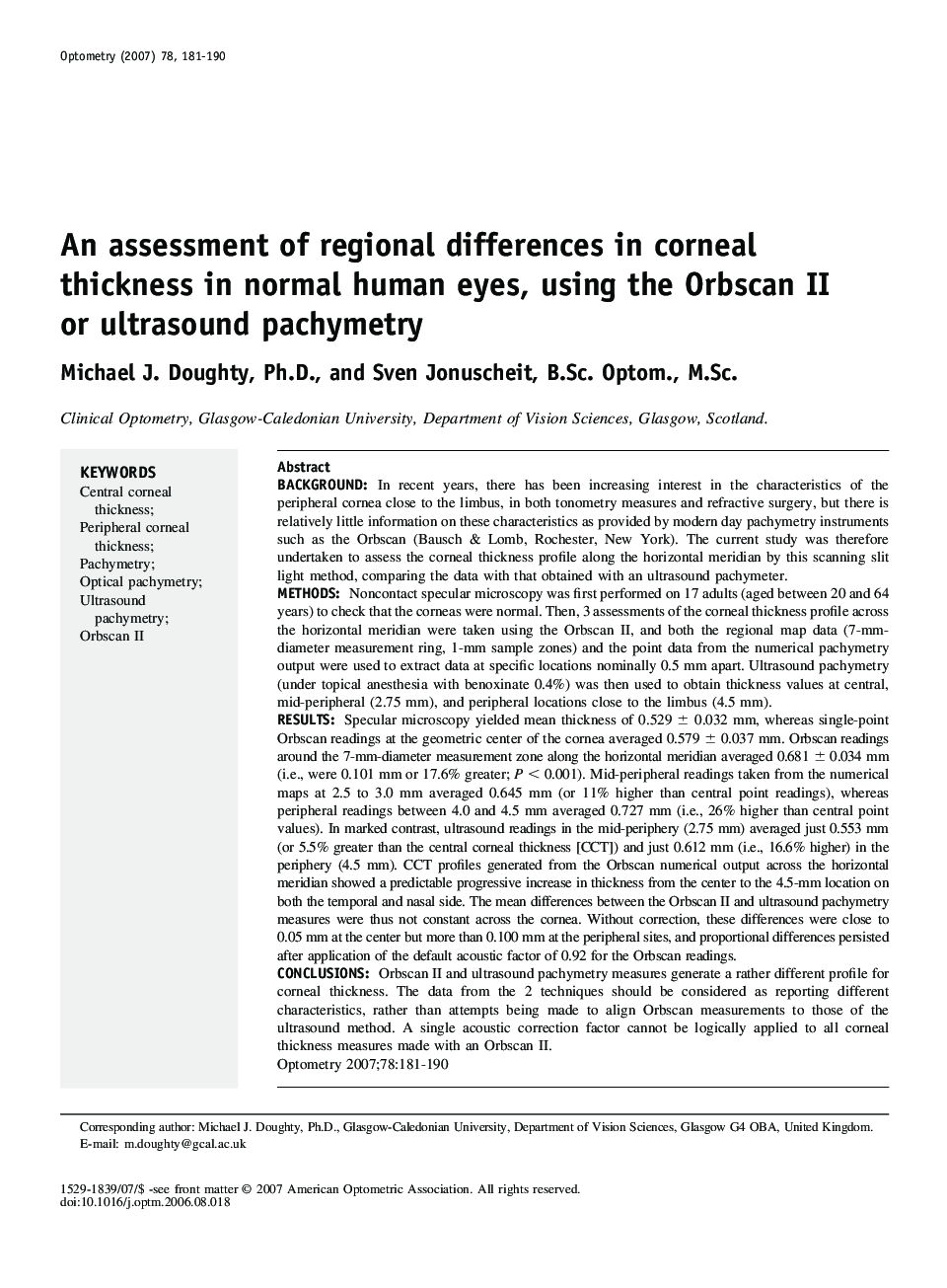| کد مقاله | کد نشریه | سال انتشار | مقاله انگلیسی | نسخه تمام متن |
|---|---|---|---|---|
| 2699674 | 1565078 | 2007 | 10 صفحه PDF | دانلود رایگان |

BackgroundIn recent years, there has been increasing interest in the characteristics of the peripheral cornea close to the limbus, in both tonometry measures and refractive surgery, but there is relatively little information on these characteristics as provided by modern day pachymetry instruments such as the Orbscan (Bausch & Lomb, Rochester, New York). The current study was therefore undertaken to assess the corneal thickness profile along the horizontal meridian by this scanning slit light method, comparing the data with that obtained with an ultrasound pachymeter.MethodsNoncontact specular microscopy was first performed on 17 adults (aged between 20 and 64 years) to check that the corneas were normal. Then, 3 assessments of the corneal thickness profile across the horizontal meridian were taken using the Orbscan II, and both the regional map data (7-mm-diameter measurement ring, 1-mm sample zones) and the point data from the numerical pachymetry output were used to extract data at specific locations nominally 0.5 mm apart. Ultrasound pachymetry (under topical anesthesia with benoxinate 0.4%) was then used to obtain thickness values at central, mid-peripheral (2.75 mm), and peripheral locations close to the limbus (4.5 mm).ResultsSpecular microscopy yielded mean thickness of 0.529 ± 0.032 mm, whereas single-point Orbscan readings at the geometric center of the cornea averaged 0.579 ± 0.037 mm. Orbscan readings around the 7-mm-diameter measurement zone along the horizontal meridian averaged 0.681 ± 0.034 mm (i.e., were 0.101 mm or 17.6% greater; P < 0.001). Mid-peripheral readings taken from the numerical maps at 2.5 to 3.0 mm averaged 0.645 mm (or 11% higher than central point readings), whereas peripheral readings between 4.0 and 4.5 mm averaged 0.727 mm (i.e., 26% higher than central point values). In marked contrast, ultrasound readings in the mid-periphery (2.75 mm) averaged just 0.553 mm (or 5.5% greater than the central corneal thickness [CCT]) and just 0.612 mm (i.e., 16.6% higher) in the periphery (4.5 mm). CCT profiles generated from the Orbscan numerical output across the horizontal meridian showed a predictable progressive increase in thickness from the center to the 4.5-mm location on both the temporal and nasal side. The mean differences between the Orbscan II and ultrasound pachymetry measures were thus not constant across the cornea. Without correction, these differences were close to 0.05 mm at the center but more than 0.100 mm at the peripheral sites, and proportional differences persisted after application of the default acoustic factor of 0.92 for the Orbscan readings.ConclusionsOrbscan II and ultrasound pachymetry measures generate a rather different profile for corneal thickness. The data from the 2 techniques should be considered as reporting different characteristics, rather than attempts being made to align Orbscan measurements to those of the ultrasound method. A single acoustic correction factor cannot be logically applied to all corneal thickness measures made with an Orbscan II.
Journal: Optometry - Journal of the American Optometric Association - Volume 78, Issue 4, April 2007, Pages 181–190